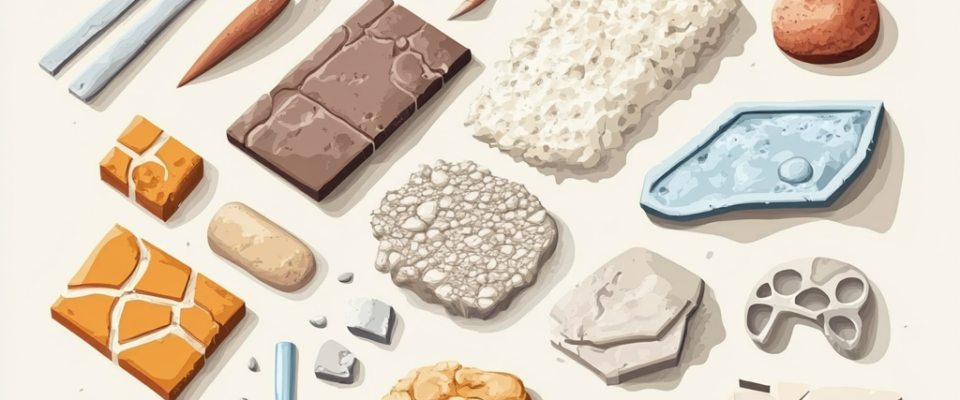- Historical aspects of the use of biomaterials in construction
- Types of biomaterials: classification and properties
- Application of gypsum in construction
- Clay plasters: traditions and innovations
- Environmental and economic benefits of biomaterials
- Prospects and development of the use of biomaterials in modern architecture
- Questions and answers
Historical aspects of the use of biomaterials in construction
The use of biomaterials in construction has deep historical roots. Ancient civilizations such as the Egyptians and Romans actively used natural materials to create structures. For example, gypsum was widely used to decorate walls and create statues. Its availability and ease of use made it a popular material in ancient times.
In addition to gypsum, clay and other natural materials were also used in ancient times to ensure the durability and comfort of buildings. These materials not only protected well from external influences, but also had excellent thermal insulation properties. Traditions of using biomaterials have been passed down from generation to generation, which ensured their dissemination and preservation of knowledge about them to this day.
Types of biomaterials: classification and properties
Biomaterials can be classified according to various criteria, such as origin, composition and scope of application. These include materials such as gypsum, clay, lime, natural fibers and wood. Each of these materials has unique properties that make them suitable for different construction needs.
Gypsum, for example, is known for its lightness and ease of processing, making it ideal for finishing work. Clay, on the other hand, has excellent thermal insulation properties and plasticity, which allows you to create various decorative elements. Natural fibers such as flax and jute are used as insulation and finishing elements due to their environmental friendliness and resistance to external influences.
Application of gypsum in construction
Gypsum is one of the most ancient building materials, its use dating back thousands of years. In construction, gypsum is used to create plasters, stucco moldings, and decorative elements. Its popularity is due to its ease of use, quick drying and the ability to create various textures and shapes.
Today, gypsum is used not only for finishing work, but also as a basis for creating drywall. This material, having high strength and fire resistance, is widely used for the construction of partitions and suspended ceilings. Gypsum is also used in medicine to create plaster casts, which demonstrates its versatility and safety.
Clay plasters: traditions and innovations
Clay plasters have a long history of use in construction and have been used for thousands of years to finish walls. Traditionally, clay was mixed with straw or other fibers to improve strength properties. These plasters provided good thermal insulation and created a comfortable indoor microclimate.
In modern construction, clay plasters are becoming popular again due to their environmental benefits and decorative capabilities. Modern technologies make it possible to improve their properties by adding various natural additives to increase strength and durability. Clay plasters can be used to create unique textures and shades, making them attractive to interior designers.
Environmental and economic benefits of biomaterials
Biomaterials have a number of environmental and economic advantages, which makes them attractive for modern construction. Firstly, they are renewable resources, which reduces the burden on the environment. In addition, biomaterials typically require less energy to produce and process than synthetic materials, reducing greenhouse gas emissions.
The economic benefits of biomaterials are also significant. For example, materials such as clay and gypsum are affordable and do not require complex processing technologies. This makes them economical to build, especially in regions with limited resources. In addition, the use of local biomaterials reduces transport costs and stimulates the development of the local economy.
Prospects and development of the use of biomaterials in modern architecture
Modern architecture increasingly focused on sustainable development and environmental friendliness. In this context, biomaterials play an important role by offering environmentally friendly and sustainable solutions. In the future, the use of materials such as clay, gypsum and natural fibers in the construction of residential and commercial buildings is expected to increase.
- Environmental sustainability: Biomaterials such as clay and wood are renewable resources, which help reduce environmental impacts. The use of such materials reduces CO2 emissions and contributes to the conservation of natural resources.
- Energy efficiency: Biomaterials have good thermal insulation properties, which can significantly reduce the cost of heating and cooling buildings. This is especially important in the context of rising energy prices and the desire for energy efficiency.
- Aesthetic value: Natural materials create unique textures and shades that cannot be achieved with synthetic materials. This allows architects and designers to create unique and aesthetically pleasing spaces.
- Health and comfort: Biomaterials, such as clay plasters, do not contain harmful chemicals and help create a healthy indoor climate. They regulate humidity and provide good breathability, which has a positive effect on the health of residents.
- Development prospects: In the future, increased investment in the research and development of new biomaterials is expected, which will improve their properties and expand their applications. This will create new opportunities for architects and builders seeking to create sustainable and energy efficient buildings.
The use of biomaterials in construction opens up new horizons for sustainable development and improving the quality of life. Their environmental and economic benefits, as well as their aesthetic value, make them an integral part of modern architecture. With growing interest in environmentally friendly technologies, we can expect a further increase in the share of biomaterials in construction.
Questions and answers
Answer 1: The ancient Egyptians and Romans used plaster to decorate walls and create statues.
Answer 2: Gypsum, clay, lime, natural fibers and wood.
Answer 3: For creating plasters, drywall, partitions and suspended ceilings.
Answer 4: Good thermal insulation, creation of a comfortable microclimate, decorative possibilities.
Answer 5: Affordable, easy to process, reduce transportation costs, stimulate the local economy.

